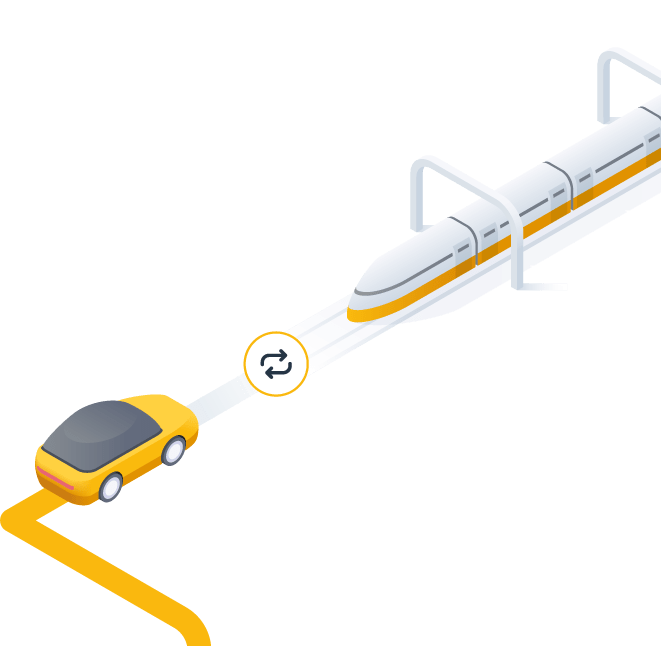T
T
When Uber acquired Autocab.
In August 2020, Uber released its big news that it will acquire the UK company, Autocab.
In addition to providing the UK’s largest cloud-based taxi booking platform in the UK, called iGo, Autocab is also widely used for its referral network for taxi and private hire operators and its GPS fleet management system. Enabling digitalisation for over 1,500 taxi companies, Autocab became the largest supplier of booking & dispatch systems in the world.
Upon the acquisition, Uber stated the acquisition should influence neither the way the iGo platform works nor the apps of Autocab’s customers, local taxi operators across the UK, built with Autocab technology.
However, in smaller UK cities the Uber app now connects customers with local drivers. So, for example, if you open the Uber app in Oxford, Exeter or Plymouth, the ‘Local cab’ option will connect you with the local taxi companies.

The Competition and Markets Authority (CMA), the UK watchdog organisation, has launched an investigation of the aquistion’s effects on competition, as the deal raises many concerns, despite Uber’s promise to stay away from Autocab’s business.
The problem is the what if scenario.
Although the CMA only found indirect competition between Uber and local dispatchers, there continues to be under further assessment since Uber is a rather complicated platform to compare to other competitors.
The CMA report addresses the fact that Uber can use Autocab’s data for its own benefit, like for spotting trends and market opportunities. Such insight gives this massive ride-hail company a further leg up above the competition.
What’s even more problematic to the health of the market, is that Uber could easily decide to launch their services and drivers in smaller UK cities. This move would make Uber a direct competitor for those local providers who use Autocab.
In such a case, they would have the competitive advantage with potential control over prices, service provider profits, and commission fees. These advantages could result in faster pickups, cheaper rides, and better service conditions for Uber. Naturally, this will pull not just customers, but also drivers.
Uber isn’t just a taxi dispatcher.
Nevertheless, the direct competition between the two companies at this point in time is just hypothetical. Right now, the acquisition offers several benefits for Uber resulting from unequal, yet just legal, competition with local providers.
According to Autocab’s CEO, Safa Alkateb, Uber’s aspirations reach to be “the Amazon of ground transportation”, following an aggregator business model to the likes of Booking.com.
Uber’s aspirations reach to be “the Amazon of ground transportation",
Global aggregation: A reasonable scenario.
Aggregated market places, like Bookings.com or Amazon, do bring benefits for both customers and suppliers in the short-term.
In the context of on-demand ground transportation, customers can enjoy better services like shorter waiting times resulting from more capacity availability.
For suppliers, they can benefit from more driver opportunities, operational efficiency resulting from higher fleet utilisation, or even new resources for innovation.
But, in the long run, aggregation platforms do have the ability to dominate the market.
The first negative effect this can bring as the demand owner or aggregator influences prices for end-users, is that they can implement pricing policies, such as predatory pricing or price increases.

Grow your ride-hailing business with intermodality
Learn how you can:
- Boost search to ride conversion rate
- Increase ride frequency and average revenue per user
- Improve vehicle utilisation and fleet efficiency
Download our free case study to find out how you can grow your ride-hailing business sustainably by providing intermodal service to customers.

The second negative effect an aggregated model can bring is that the demand owner decides where and how the service will be provided, along with the service fees for the providers.
If Uber takes advantage of these two windows of opportunities, they can easily have more customers and profit than ever, but at the expense of service providers and customers.
This would leave traditional taxi dispatchers stripped to simply being fleet operators and capacity suppliers, should all the demand aggregate under Uber’s brand.
Traditional taxi dispatchers would be stripped to being nothing more than fleet operators and capacity suppliers.
At this point, Uber can become a direct competitor or global aggregator, and either way, they would gain massive competitive advantage.
A solution? A transparent, accountable, and regulated marketplace.
A total ban on aggregation is not a solution — regulation is what is needed. However, it’s very complex to regulate such digital marketplaces as they evolve fast, and are difficult to define often.
What we need is a new and smart approach to aggregated markets, that allows for growth with regulation in the right areas and competition among sellers.
This transformation requires proprietary, closed, and exclusive infrastructures that are accessible and non-discriminatory. With software, its protocols, and non-personal data or providing access to the order book, this can be done.

Such application is certainly more difficult to apply with existing aggregators, but it’s a much more feasible task to start developing as the aggregation is developing itself from a younger stage, giving more space for intervention. Setting rules earlier in the game makes them easier to apply.
While there will be primary winners in such a market system, the negative effects can be limited, hindering the chance of a monopoly and allowing for fairer competition.
Governance and separation of duties: two golden keys.
Agile regulation can allow for innovation and economic growth, while minimising negative externalities.
In the context of the ride-hail & taxi realm, this agile governance should effectively help bring passengers the benefits from aggregation — good quality and affordable transportation — just as they benefit from cheap and accessible vacancies on Booking.com.
In a closed marketplace, the marketplace owner tends to control both sides of the transaction for buyers and sellers. This is why it is important to make key roles — like marketplace owners, demand owners, and supply owners — separate.
With separating, these roles can hold one another accountable. This is one of the best tools which can be leveraged in an aggregated market to ensure fair play and optimal transactions for all parties involved.
Demand owner and quality guarantee.
Owning market demand shouldn’t come without the responsibility for service quality and availability.
It’s too easy for demand owners to “cherry-pick” for most profitable orders. This can be mitigated if they are to adopt a model similar to the way public transport operates.
In application, this requires the operator to work in areas even if the demand is not as unit profitable. The key to this harmonisation is keeping it profitable enough for the supplier.
Demand owners should guarantee fair competition between market players. In other words, demand owners shouldn’t prioritise suppliers who pay a higher commission, nor to their own brand supply.

The adherence to this should be watched and controlled digitally, followed by non-compliance penalties. This way, a regulation of private hire vehicles can be more agile and fair, reflecting current situations within time windows as brief as one hour in hyper-local, small residential areas.
If that feels too far-fetched, let’s recall how we mitigate a similar negative externality: pollution. The Emission Trading system made it possible to jointly monitor and penalise the production of greenhouse gases. Companies that don’t comply, are charged carbon credits.
Supply owner collaboration.
Capacity suppliers need to be held accountable to minimizing their negative impacts on the whole market ecosystem. For example, a supply owner should not churn out more cars without first optimising utilisation of their current fleet.
Increasing utilisation is such a case, means to be open to receiving more demand regardless of its origin. Supply owners need to open their booking capacity in such a way that allows for any demand owner to connect with a ride.
Increasing utilisation is such a case, means to be open to receiving more demand regardless of its origin.
At the same time, supply owners should manage their capacity and adjust their fleet to be matched and optimised with only as many cars as can be utilised at the time.
Marketplace owners’ role.
Marketplace owners in this ecosystem also need to play their role in being accountable. They should open data at reasonable aggregated levels. This will enable governing bodies to measure and enforce regulations, while also protecting the privacy of drivers and passengers involved.
Additionally, marketplace owners should allow buyers and sellers, including demand aggregate platforms, to play within the marketplace under non-discriminant rules.

The adherence to this should be watched and controlled digitally, followed by non-compliance penalties. This way, a regulation of private hire vehicles can be more agile and fair, reflecting current situations within time windows as brief as one hour in hyper-local, small residential areas.
If that feels too far-fetched, let’s recall how we mitigate a similar negative externality: pollution. The Emission Trading system made it possible to jointly monitor and penalise the production of greenhouse gases. Companies that don’t comply, are charged carbon credits.
Supply owner collaboration.
Capacity suppliers play a vital role in a healthy infrastructure system and it’s very important that they consider themselves as part of a bigger body, rather than completely separate competing entities.
Adjusting the fleet size to the fleet utilisation so that the supply owner would provide only as many cars as can be utilised at the time is important for this. Furthermore, it requires suppliers to respect limitations for the size of their driver base.
Such a strategy also encourages partnerships with multiple demand owners, allowing suppliers to bring in more ride orders and transactions.
Such a strategy also encourages partnerships with multiple demand owners, allowing suppliers to bring in more ride orders and transactions.
Digitisation provides many possibilities to monitor and control adherence of such duties on a far more granular level than ever before.
What could the marketplace look like?
All key stakeholders — customers, business owners, and city authorities — can enjoy the benefits of separation of duties.
Customers can have good-quality service, even at currently low serviced areas that aren’t necessarily profitable, at an affordable cost.
Business owners can provide fairly priced services with reasonable vehicle utilisation, benefiting from the fair-play market environment.

And finally, everyone would benefit if there were more controls in place to decrease the negative externalities associated with urban transportation. So we’d end up with healthier and happier residents in more liveable, cleaner cities.
It’s naive to anticipate such strides without any interventions set in place. And here, our collective responsibility as a mobility sector to observe, analyse, and act comes again.
Once we start co-creating an approach to such regulation, new questions will continue to arise and shape its application. How can we start forming an independent digital platform that would serve the purpose? And how to ensure regulation is fair to all involved parties?
It’s a long and winding road, and the first steps must come from thinking, discussing, and collaborating on potential solutions. I’m curious to hear your thoughts.
Feel welcome to connect with me on Linkedin or leave your contact with us here. I’ll be more than happy to get back to you and exchange ideas. Looking forward to great discussions!
.
For more blog posts and urban mobility updates, follow Mileus on LinkedIn:









